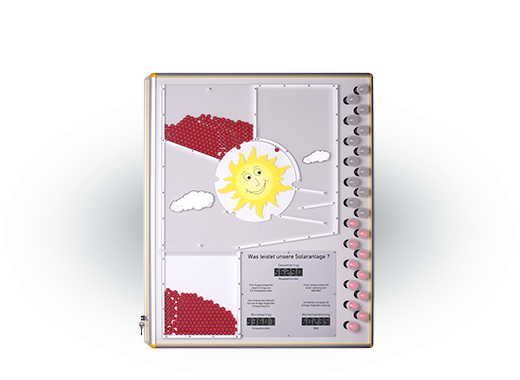
VisiKid
In an unusual fashion, the display presents the performance data of PV plants on public buildings.

VisiKid
In an unusual fashion, the display presents the performance data of PV plants on public buildings.
System for the child-friendly display of the energy yielded by photovoltaic plants.
Plants for Nurseries and Schools Set an Example
It enables the direct conversion of sunlight into electrical energy through solar cells - that is why photovoltaics is one of the most popular sources of renewable energy; that is why solar power plants are increasingly being installed on the roofs of nurseries and schools. The aim is both to set an example and teach children about renewable sources of energy.
Display of Yield Not Child-Friendly Until Now
The "standard solution" is typically used to show plant yield: a large digital display gives the current output and the energy supplied to the grid. However, this display usually fails to awake any interest and is ultimately incomprehensible for the majority of pupils and parents.
New Display Concept
That is why the Münster University of Applied Sciences developed a new display concept as part of a student's final year project. It was then taken up by IKS Photovoltaik - the licence partner - and developed further until it was ready for series production.
Current electrical output is clearly shown by 24 representative light bulbs (LEDs) on an analogue display: children associate electricity above all with light bulbs, which are a familiar part of their everyday lives. The greater the current plant output, the greater the number of light bulbs illuminated.
Balls clearly display the energy supplied to the grid in the current month. A step motor-controlled wheel sends balls from a storage container along a ball run and into a transparent collection container. As more and more energy is generated over the course of the month, the number of balls in the second container increases.
At the end of the month, the container is tipped up, the balls returned to the top container and the digital monthly display reset to zero.
There are also digital displays showing the current output, monthly yield and total yield.
Developed in collaboration with Münster University of Applied Sciences.

